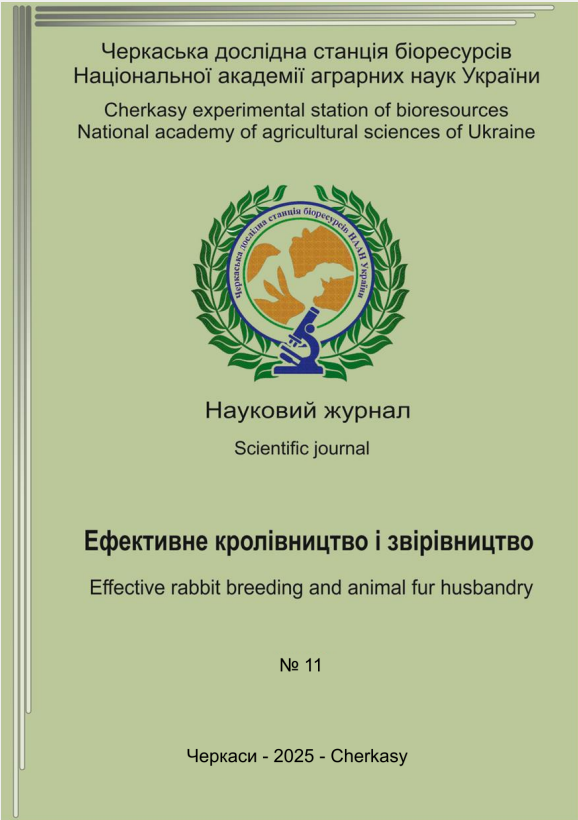Toxico-ecological characteristics of tocopherol and selenium complex on rabbits in the context of school teaching of biology and chemistry
DOI:
https://doi.org/10.37617/2708-0617.2025.11.239-249Keywords:
toxicology,Abstract
The article presents the results of a toxicological and ecological study of the veterinary drug "Devivit Selen", containing tocopherol and selenium, on laboratory rabbits. One milliliter of the drug contains active ingredients (mg): alpha-tocopherol acetate (vitamin E) - 50.0; selenium (in the form of sodium selenite) - 0.5. Excipients: benzyl alcohol, sodium hydroxide, water for injection. The study aimed to determine the safety of the drug for further clinical use, as well as the possibility of integrating scientific results into school biology and chemistry teaching. It was established that when applied to the skin in doses up to 3000 mg/kg of body weight and instilled into the eye, the drug does not cause toxic reactions, irritation of the skin or mucous membrane, which allows it to be classified as class IV of low-hazard substances.
The experiment was conducted in compliance with bioethical standards. Standard toxicological assessment methods were used, in particular the point system for determining the irritant effect. In addition to the scientific aspect, special attention was paid to the didactic potential of the study: the authors developed integrated educational tasks for school biology and chemistry courses. Students are offered the analysis of experimental data, calculation of dosages, study of the antioxidant properties of tocopherol and the trace element action of selenium. This approach contributes to the formation of interdisciplinary connections, the development of critical thinking and interest in natural sciences.
The results of the study have not only veterinary and medical, but also pedagogical significance, in particular for the creation of STEM lessons based on real experimental data. The proposed material can serve as an effective tool for integrating modern science into the educational process.
In the future, it is advisable to expand the range of toxicological tests of the tocopherol and selenium complex, including studies of chronic toxicity, effects on reproductive function and genetic stability. Also a promising direction is the study of the interaction of the complex with other biologically active substances and the development of educational STEM modules based on real data of veterinary toxicology for secondary education institutions.
References
Сачук, Р.М., та ін. (2024). Визначення подразнювальної дії залізовмісного ветеринарного препарату на кролях: результати доклінічних досліджень. Ефективне кролівництво і звірівництво. Черкаси: Черкаська дослідна станція біоресурсів НААН, Вип. 10. 157 – 168с.
Sachuk, R.M., Gutyj, B.V., Radzyhovskyi, M.L., Velesyk, T.A., Lyko, S.M., Katsaraba, O.A., Pepko, V.O., Yakuta, O.O. (2023). Research on the embryotoxic effect and carcinogenicity of the drug “BTF plus” – a means for normalizing metabolic processes in animals and poultry // Ukrainian Journal of Veterinary and Agricultural SciencesVol. 6, № 3. 17 – 23p. doi: 10.32718/ujvas6-3.04.
Сачук, Р.М., та ін. (2023). Дослідження специфічної токсичності препарату “БТФ плюс” – засобу для нормалізації обмінних процесів у тварин і птиці . Науковий вісник Львівського національного університету ветеринарної медицини та біотехнологій імені С.З. Ґжицького. Серія: Ветеринарні науки. Т. 25, № 111. 33 – 42с. doi: 10.32718/nvlvet11106.
El-Sheikh, E.A., Mahrose, K.M., Ismail, I.E. (2015). Dietary exposure effect of sublethal doses of methomyl on growth performance and biochemical changes in rabbits and the protective role of vitamin Е plus selenium Egyptian Journal of Rabbit Science. Vol. 25, № 1. 59 – 81p.
Ebeid, T.A., Zeweil, H.S., Basyony, M.M., Dosoky, W.M., Badry, H.(2013). Fortification of rabbit diets with vitamin E or selenium affects growth performance, lipid peroxidation, oxidative status and immune response in growing rabbits Livestock Science. Vol. 155, Issues 2 – 3. 323 – 331p.
Ткачук, О.М., Ткачук, Т.В. (2021). Кролі як біологічна модель для експериментальних досліджень (огляд літератури). Ukrainian Journal of Modern Problems of Toxicology. № 2. 109 – 114c. doi: 10.33273/2663-4570-2021-91-2-109-114.
Перелік зареєстрованих в Україні ветеринарних лікарських засобів [Електронний ресурс]. – Режим доступу: https://data.gov.ua/dataset/8f3e00b2-16e8-4b30-af7d-b9212837b0a6.
Коцюмбас, І.Я., Бух, М.Ю. та ін. (2017). та ін.; Ветеринарні лікарські засоби. Львів: ТзОВ ВФ «Афіша». 1632 с.
Коцюмбас, І.Я., Малик, О.Г., Патерега, І.П. та ін.(2006). Доклінічні дослідження ветеринарних лікарських засобів . Львів: Тріада плюс. 360 с.
Гончарук, Є.Г., Кундієв, Ю.І., Бардов, В.Г. та ін. (1995). Керівництво по лабораторним тваринам і альтернативним моделям в біомедичних дослідженнях. К.: Вища школа. 138 – 142c.
Даценко, І.І. та ін. (2001). Лабораторні тварини. Розведення, утримання, використання в експерименті Львів: Світ, 472 с.
European convention for the protection of vertebrate animals used for experimental and other scientific purposes. (1986). Strasbourg: Council of Europe, 53 p.
Council Directive 86/609/EEC of 24 November 1986 on the approximation of laws, regulations and administrative provisions of the Member States regarding the protection of animals used for experimental and other scientific purposes. Official Journal of the European Communities. L 358. 1 – 29 p.
Коцюмбас, І.Я., Коцюмбас, Г.І., Голубій, Є.М. та ін. (2009). Комплексна оцінка впливу ветеринарних препаратів на морфофункціональний стан імунної системи: Методичні рекомендації. Львів, 63 с.


